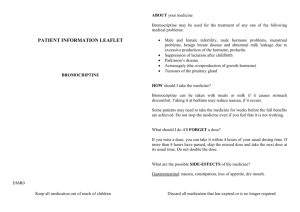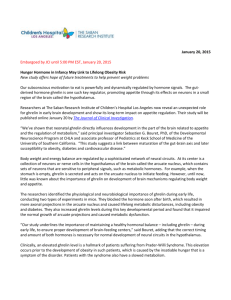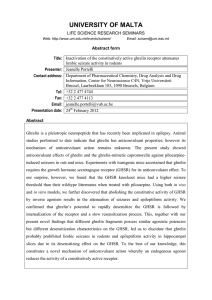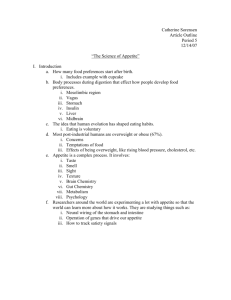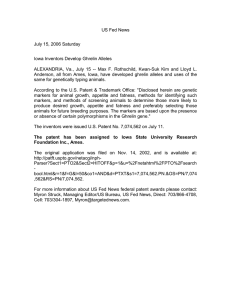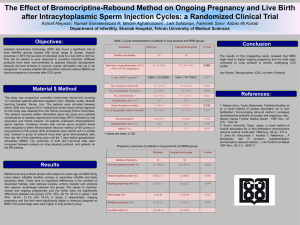Document 13310717
advertisement
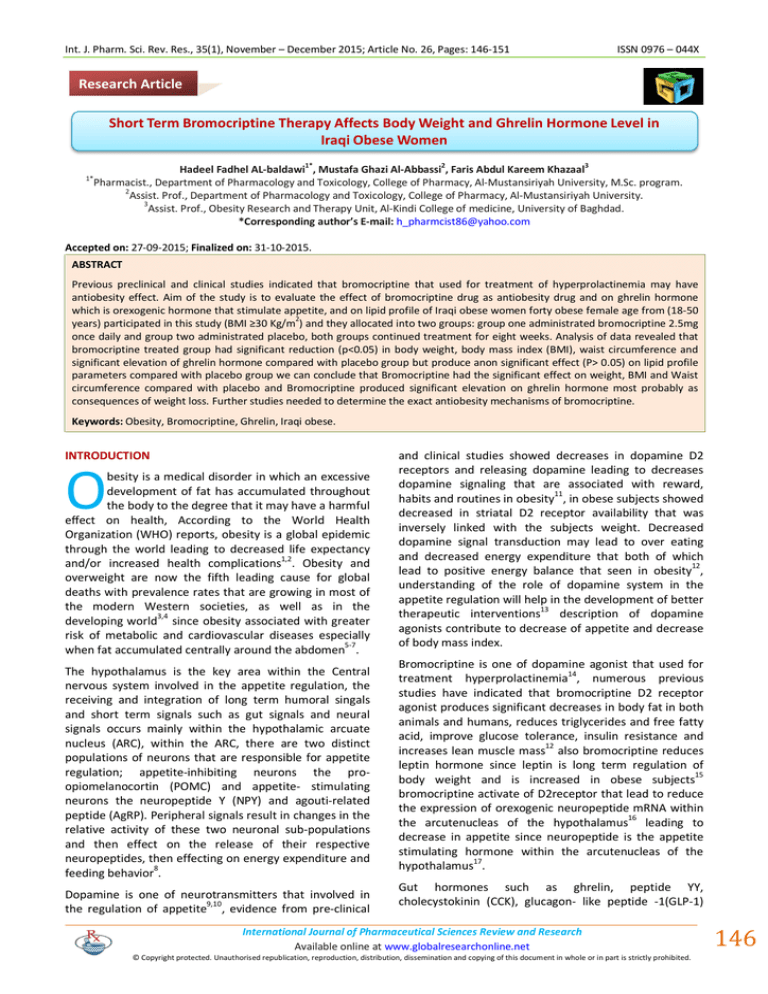
Int. J. Pharm. Sci. Rev. Res., 35(1), November – December 2015; Article No. 26, Pages: 146-151 ISSN 0976 – 044X Research Article Short Term Bromocriptine Therapy Affects Body Weight and Ghrelin Hormone Level in Iraqi Obese Women 1* 2 3 Hadeel Fadhel AL-baldawi , Mustafa Ghazi Al-Abbassi , Faris Abdul Kareem Khazaal Pharmacist., Department of Pharmacology and Toxicology, College of Pharmacy, Al-Mustansiriyah University, M.Sc. program. 2 Assist. Prof., Department of Pharmacology and Toxicology, College of Pharmacy, Al-Mustansiriyah University. 3 Assist. Prof., Obesity Research and Therapy Unit, Al-Kindi College of medicine, University of Baghdad. *Corresponding author’s E-mail: h_pharmcist86@yahoo.com 1* Accepted on: 27-09-2015; Finalized on: 31-10-2015. ABSTRACT Previous preclinical and clinical studies indicated that bromocriptine that used for treatment of hyperprolactinemia may have antiobesity effect. Aim of the study is to evaluate the effect of bromocriptine drug as antiobesity drug and on ghrelin hormone which is orexogenic hormone that stimulate appetite, and on lipid profile of Iraqi obese women forty obese female age from (18-50 2 years) participated in this study (BMI ≥30 Kg/m ) and they allocated into two groups: group one administrated bromocriptine 2.5mg once daily and group two administrated placebo, both groups continued treatment for eight weeks. Analysis of data revealed that bromocriptine treated group had significant reduction (p<0.05) in body weight, body mass index (BMI), waist circumference and significant elevation of ghrelin hormone compared with placebo group but produce anon significant effect (P> 0.05) on lipid profile parameters compared with placebo group we can conclude that Bromocriptine had the significant effect on weight, BMI and Waist circumference compared with placebo and Bromocriptine produced significant elevation on ghrelin hormone most probably as consequences of weight loss. Further studies needed to determine the exact antiobesity mechanisms of bromocriptine. Keywords: Obesity, Bromocriptine, Ghrelin, Iraqi obese. INTRODUCTION O besity is a medical disorder in which an excessive development of fat has accumulated throughout the body to the degree that it may have a harmful effect on health, According to the World Health Organization (WHO) reports, obesity is a global epidemic through the world leading to decreased life expectancy and/or increased health complications1,2. Obesity and overweight are now the fifth leading cause for global deaths with prevalence rates that are growing in most of the modern Western societies, as well as in the developing world3,4 since obesity associated with greater risk of metabolic and cardiovascular diseases especially when fat accumulated centrally around the abdomen5-7. The hypothalamus is the key area within the Central nervous system involved in the appetite regulation, the receiving and integration of long term humoral singals and short term signals such as gut signals and neural signals occurs mainly within the hypothalamic arcuate nucleus (ARC), within the ARC, there are two distinct populations of neurons that are responsible for appetite regulation; appetite-inhibiting neurons the proopiomelanocortin (POMC) and appetite- stimulating neurons the neuropeptide Y (NPY) and agouti-related peptide (AgRP). Peripheral signals result in changes in the relative activity of these two neuronal sub-populations and then effect on the release of their respective neuropeptides, then effecting on energy expenditure and feeding behavior8. Dopamine is one of neurotransmitters that involved in the regulation of appetite9,10, evidence from pre-clinical and clinical studies showed decreases in dopamine D2 receptors and releasing dopamine leading to decreases dopamine signaling that are associated with reward, habits and routines in obesity11, in obese subjects showed decreased in striatal D2 receptor availability that was inversely linked with the subjects weight. Decreased dopamine signal transduction may lead to over eating and decreased energy expenditure that both of which lead to positive energy balance that seen in obesity12, understanding of the role of dopamine system in the appetite regulation will help in the development of better therapeutic interventions13 description of dopamine agonists contribute to decrease of appetite and decrease of body mass index. Bromocriptine is one of dopamine agonist that used for treatment hyperprolactinemia14, numerous previous studies have indicated that bromocriptine D2 receptor agonist produces significant decreases in body fat in both animals and humans, reduces triglycerides and free fatty acid, improve glucose tolerance, insulin resistance and 12 increases lean muscle mass also bromocriptine reduces leptin hormone since leptin is long term regulation of body weight and is increased in obese subjects15 bromocriptine activate of D2receptor that lead to reduce the expression of orexogenic neuropeptide mRNA within the arcutenucleas of the hypothalamus16 leading to decrease in appetite since neuropeptide is the appetite stimulating hormone within the arcutenucleas of the hypothalamus17. Gut hormones such as ghrelin, peptide YY, cholecystokinin (CCK), glucagon- like peptide -1(GLP-1) International Journal of Pharmaceutical Sciences Review and Research Available online at www.globalresearchonline.net © Copyright protected. Unauthorised republication, reproduction, distribution, dissemination and copying of this document in whole or in part is strictly prohibited. 146 © Copyright pro Int. J. Pharm. Sci. Rev. Res., 35(1), November – December 2015; Article No. 26, Pages: 146-151 act as a meal initiators and terminators and have a physiological role in control of appetite and satiety18,19. Ghrelin is the most powerful orexigenic peptide hormone that leads to increase food intake and decrease energy expenditure, in order to understand the orexogenic effect of ghrelin, intracerebroventicular injection of ghrelin hormone into mice and rodents show increase food intake and decrease energy expenditure result in weight gain and increase their total body weight. Also intravenous and subcutaneous injection also leads to increase food intake. Ghrelin is serving as peripheral GI signal produced from gastrointential organs and transmitted to the CNS in response to hunger in order to stimulate food intake20. Appetite stimulating effect of ghrelin is mediated by hypothalamus by attenuates leptin induced reduction in food intake and body weight by effecting on the expression of various hypothalamic peptides. Second, Ghrelin stimulates and increases the activity of neurons that expressing orexogenixc neuropeptide (NPY), agouti related peptides (AgRP) and orexin. Third, ghrelin has an inhibitory effect on anorexogenic pro-opiomelanocortin (POMC) neurons and CRH-producing neurons21. Recent evidences showed interaction between ghrelin and dopamine system that may effect on food intake such as ablation of ghrelin receptors lead to reduce the anorexgenic effect of activation of D2 receptors, and an experiment done on rodents indicated that specific central blocking or stimulation of dopamine receptors (D1,D2,D3) lead to specific reducing of ghrelin orexogenic effect22. SUBJECTS AND METHODS Forty premenopausal obese Iraqi female patients with BMI> 30 kg/m2 with an age range (18-50) were randomly allocated to one of these two groups, group I Includes 16 female patients administrated placebo capsule for 8 weeks in a dose of one capsule administered once daily. ISSN 0976 – 044X And group II Includes 24 female patients treated for 8 weeks with (bromocriptine) in a dose of one tablet (2.5mg) administered once daily. Drug and medical history was taken from each patient and excluded diseases such as heart, renal, hepatic diseases, uncontrolled thyroid dysfunction, hyperprolactinemia, polycystic ovarian syndrome and diabetic mellitus, also excluded women with pregnancy, lactation and women on contraceptive. All participants were advised to take low carbohydrate dietary therapy and median intensity of aerobic exercise for 60 minutes during their treatment for duration of 8 weeks. Blood samples were collected from all the participants at the start of the treatment (baseline samples) and after 8 weeks of starting treatment to measure the possible change in the studied parameters such as hormonal parameter (ghrelin) and lipid profile parameters (Total cholesterol, HDL, triglycerides). VLDL, LDL were calculated from measured parameters. The patient’s anthropometrics were measured also at the beginning of the study and after 8 weeks of starting treatment, weight was measured on a calibrated balance beam scale, height was measured with a wall-mounted stadiometer, for all participants to calculate body mass index (BMI), in order to estimate central obesity, waist circumference was measured in centimeters also for all participants. The blood samples were collected in plain tubes and centrifuged at 4000 rpm for 20 minutes and then stored frozen until biochemical analysis, total ghrelin measured by enzyme linked immuno sorbent assay (ELISA) (Mybiosource, USA), lipid profile parameters measured by (Human, Germany). The results are presented as mean ± SD in two sample T test in the baseline comparison between the two groups and then data were analyzed by using the analysis of covariance (ANCOVA) after adjusted means of both groups the results presented as mean±SE. The significance level for all tests was taken as P value less than 0.05.and percentage of difference between the baseline and end line was calculated for both groups. RESULTS Table 1: Two sample t-test showing measurements of age, weight, waist and BMI of Bromocriptine and placebo groups at start point of treatments Age Height (cm) Weight (kg) Waist (cm) 2) BMI (kg/m Mean St Dev Bromocriptinegp, N24 33.17 6.82 Placebo gp. N16 32.6 10.32 Bromocriptinegp, N24 1.59 0.05 Placebogroup, N16 1.57 0.07 Bromocriptinegp, N24 100.9 19.9 Placebo gp. N16 95.6 16.8 Bromocriptinegp, N24 116.04 8.75 Placebo gp. N16 113.4 11.7 Bromocriptinegp, N24 39.75 5.41 Placebo gp. N16 38.47 4.54 P-Value 0.856 0.26 0.294 0.455 0.42 International Journal of Pharmaceutical Sciences Review and Research Available online at www.globalresearchonline.net © Copyright protected. Unauthorised republication, reproduction, distribution, dissemination and copying of this document in whole or in part is strictly prohibited. 147 © Copyright pro Int. J. Pharm. Sci. Rev. Res., 35(1), November – December 2015; Article No. 26, Pages: 146-151 ISSN 0976 – 044X All patients were matched at least in the clinical parameters before treatment as shown in the table (1) that revealed no significant differences in these parameters between the bromocriptine and placebo groups. Table 2: Comparison of adjusted effect of treatment for weight, BMI, waist circumference, ghrelin, lipid profile according to covariance Weight (Kg) 2 BMI (kg/m ) Waist (cm) Ghrelin (pg/ml) Total cholesterol (mg/dl) HDL (mg/dl) Triglycerides (mg/dl) VLDL (mg/dl) LDL(mg/dl) Adjusted baseline Mean Adjusted End line (Mean±SE) Outcome (Mean±SE) Bromocriptine N24 98.745 94.234±0.585 -4.511±0.585 Placebo N16 98.745 96.696±0.719 -2.099±0.719 Bromocriptine N24 39.238 37.460±0.235 -1.778±0.235 PlaceboN16 39.238 38.460±0.288 -0.778±0.288 Bromocriptine N24 115 111.365±0.54 -3.6350±.504 Placebo N16 115 114.077±0.69 -0.923±0.619 Bromocriptine N24 659.80 707.917±5.95 48.117±5.965 Placebo N16 659.80 674.874±7.39 15.074±7.309 Bromocriptine N24 176.47 166.2±3.68 -10.2±3.68 Placebo N16 176.47 166.85±4.51 -9.6±4.5 Bromocriptine N24 39.77 41.3±1.14 1.55±1.14 Placebo N16 39.77 40.2±1.39 0.45±1.39 Bromocriptine N24 137.6 124.7±5.79 -12.9±5.79 PlaceboN16 137.6 127.1±7.09 -10.5±7.09 Bromocriptine N24 27.5 24.9±1.159 -2.5±1.15 Placebo N16 27.5 25.4±1.42 -2.1±1.42 Bromocriptine N24 109.17 99.9±3.56 -9.24±3.56 Placebo N16 109.17 101.2±4.36 -7.96±4.36 P value 0.012 0.011 0.002 0.001 0.912 0.544 0.796 0.796 0.822 Table 3: Percentage of difference for the two groups % of difference Weight BMI Waist Ghrelin T.cholesterol HDL Triglycerides VLDL LDL Bromocriptine N24 ↓ 4.55% Placebo N16 ↓ 2% Bromocriptine N24 ↓ 4.48% Placebo N16 ↓ 2% Bromocriptine N24 ↓ 3.2% Placebo N16 ↓ 0.8% Bromocriptine N24 ↑ 7.45% Placebo N16 ↑ 2.2% Bromocriptine N24 ↓5.56% Placebo N16 5.7%↓ Bromocriptine N24 ↑4.43% Placebo N16 ↑ 0.5% Bromocriptine N24 ↓9.2% PlaceboN16 ↓7.8% Bromocriptine N24 9.2%↓ Placebo N16 ↓7.8% Bromocriptine N24 8.3%↓ Placebo N16 ↓7.5% In table (3) percentage of difference between the endline and baseline means for bromcriptine group and placebo group. In table (2) After adjustment means of different parameters for the bromocriptine group and placebo group according to the covariance analysis there is significant reduction P value <0.05 in weight, BMI, waist International Journal of Pharmaceutical Sciences Review and Research Available online at www.globalresearchonline.net © Copyright protected. Unauthorised republication, reproduction, distribution, dissemination and copying of this document in whole or in part is strictly prohibited. 148 © Copyright pro Int. J. Pharm. Sci. Rev. Res., 35(1), November – December 2015; Article No. 26, Pages: 146-151 circumference in bromocriptine group compared with placebo group, and there is significant increase P value <0.05 in the level of the serum ghrelin hormone in bromocriptine group compared with placebo group but there is a non-significant difference P value >0.05 between the two groups for all lipid profile parameters. DISCUSSION Since obesity is one of the major epidemic disorder throughout the world and one of the major causes of both morbidity and mortality, the present study focused on the antiobesity effect of old drug bromocriptine (Parlodel) since antidiabetics and antiobesity effect of dopamine agonists such as bromocriptine had studied in various animals models and clinical studies23. Patients in this study were obese premenpausal females with normal prolactin levels. The analysis of data in the present study indicated that the group of patients treated with bromocriptine 2.5 mg once daily for 8 weeks combined by diet and exercise produced significant weight loss, decrease in BMI and decrease in waist circumference (P value <0.05) when compared with placebo group combined by diet and exercise according to covariance. After comparison between the two groups the bromocriptine group produce significant weight loss and significant decrease in waist circumference compared to placebo group and this is possibly because of the antiobesity effect of bromocriptine and this agree with previous study by Cincotta AH that used bromocriptine (Ergoset) a quick release formulation of bromocriptine that differ from long acting bromocriptine in pharmacokinetics where it also produce significant reduction in body weight and body fat compared with placebo when used for 18 weeks24 and also agreed with study of Doknic M that used bromocriptine for treatment of prolactinomas, bromocriptine significantly decreased BMI after 6 month (not after one month) and the reduction in prolactine levels was unrelated and not correlated with BMI,25 the only limitation of this study was the patients were complaining from prolactinomas. Also the current study agree with other study by Meier AH that states that bromocrptine decrease total body fat and decrease body weight by 2.5% when used for 6 weeks26. But disagree with Kok Pet that found bromocriptine not effective in decreasing BMI when administrated for 8 days16. And this possibly because of short duration of treatment. In the present study the loss of weight in patients on bromocriptine support the fact that there is a role of dopaminergic tone that regulate food intake and energy balance. Bromocriptine activate D2 receptor that lead to reduce expression of orexogenic neuropeptide mRNA 16 within the arcuatenucleus of the hypothalamus, and so the appetite decreased. Also bromocriptine may decrease body fat by reducing insulin stimulating hepatic lipogensis, and also by inhibiting lipolysis that lead to free 24 fatty acid reesterfication . Bromocriptine increase dopaminergic tone that may reduce lipogenesis by ISSN 0976 – 044X decreasing prolactin level that lead to decrease body fat25, bromocriptine may lead to decrease waist circumference leading to decrease the risk of central obesity and the cardiovascular diseases associated with it. Ghrelin hormone is orexogenic (appetite stimulating hormone) that have a role in short regulation of food intake as well as long term regulation of body weight27, in the present study fasting total ghrelin both (acyl and desacyl) ghrelin was measured before starting the treatment in both groups and after two months of treatment, the analysis indicated that after 8 weeks, ghrelin increase in both groups, but significantly increased more (Pvalue<0.05) in bromocriptine group, with percentage of increased of 7 %, while in placebo group 2.2%, and this is agree with previous studies that indicated significant relation between ghrelin levels and magnitude of body weight loss since bromocriptine group lost body weight 4.5% about two times greater than placebo group 2%, and this agree with Soni AC that confirmed that ghrelin significantly increase after weight loss28 the only limitation of this study was that involve overweight postmenopausal women only, also the current study agree with Gueugnon C that also confirmed that after weight loss ghrelin level increased significantly29 on obese adolescents. Also agree with study by Sumithran P that indicated weight loss lead to increase acylated ghrelin after 10 weeks of weight reduction program30 in men and postmenopausal women, but acyalted ghrelin not total ghrelin was measured, also agree with mason C that confirmed greater weight loss associated with greater increase in total ghrelin in obese or overweight postmenopausal women27. The reasons of decreasing ghrelin hormone in obese individuals may be due to increase in feeding that may reflect feedback mechanism in order to reduce appetite or it may be due to insulin resistance that associates obesity and excess weight29. Despite the lower concentration of ghrelin the lack of suppression to ghrelin 31 after meal may also responsible for obesity . Weight loss made increase in ghrelin concentration as a part of adaptive mechanism to an energy deficit in order to increase appetite and decrease energy expenditure; this increase may lead to weight regain after weight loss29. The limitation of the current study is that the direct effect of bromocriptine on ghrelin secretion hormone cannot be confirmed or excluded. In order to elaborate the effect of bromocriptine on ghrelin. Future pre-clinical and clinical studies are needed to elaborate this point. The other limitation of the current study is not measuring the acylated ghrelin, which was considered the active ghrelin that mediate ghrelin effect on regulation of body weight and appetite regulation because the acylated form is unstable and rapidly degraded, and the majority of ghrelin consist of des-acylated ghrelin, more than 90%, recent studies suggest that des-acylated ghrelin increases in response to weight loss32. International Journal of Pharmaceutical Sciences Review and Research Available online at www.globalresearchonline.net © Copyright protected. Unauthorised republication, reproduction, distribution, dissemination and copying of this document in whole or in part is strictly prohibited. 149 © Copyright pro Int. J. Pharm. Sci. Rev. Res., 35(1), November – December 2015; Article No. 26, Pages: 146-151 Bromocriptine treated group showed a non-significant effect for all lipid profile parameters including (total cholesterol, HDL, LDL, triglycerides, VLDL, non HDL cholesterol) compared to placebo group. Both Bromocriptine group and placebo group showed minor improvement in all lipid profile parameters, where percentage of reduction of lipid profile is close for both groups except for HDL, the percentage of increment is 4.2% in bromocriptine group and 0.5% in placebo group. And this improvement due to change in their lifestyle by diet and exercise in addition to weight loss. Previous studies with bromocriptine indicated that bromocriptine may have effect on dyslipidemia especially those associated with diabetes mellitus. A study by kamath V showed that the effect of rapid release bromocriptine in nondiabetic obese hyperinsulinemic women produce significant decrease in 33 triglyceride and total cholesterol also in animal study by Nade VS, the effect of bromocriptine on lipid profile in diabetic rats produced significant decrease in triglycerides and total cholesterol34. Bromocriptine increase hypothalamic dopamine signal that lead to reduce lipolysis and lipogenesis leading to decrease free fatty acid that is essential for triglycerides and VLDL production finally the result is TG and VLDL and total cholesterol decreased33-35. In the current study bomocriptine do not produce significant change in lipid profile compared to placebo, this may be due to that obese female in this study were not hyperlipidemic subjects. Future studies needed to evaluate the action of bromocriptine on hyperlipidemic subjects especially the change in HDL that showed evident elevation in comparison with placebo group in the current study. ISSN 0976 – 044X Prevention; NAASO, the Obesity Society; the American Society for Nutrition; and the American Diabetes Association,Obesity, 15(5), 2007, 1061-1067. 6. Snijder MB, Zimmet PZ, Visser M, Dekker JM, Seidell JC, Shaw JE, Independent and opposite associations of waist and hip circumferences with diabetes, hypertension and dyslipidemia: the AusDiab Study, International Journal of Obesity, 28(3), 2004, 402-409. 7. Manolopoulos KN, Karpe F, Frayn KN, Gluteofemoral body fat as a determinant of metabolic health, International Journal of Obesity, 34(6), 2010, 949-59. 8. Perry B, Wang Y. Appetite regulation and weight control: the role of gut hormones, Nutrition & diabetes, 2(1), 2012, e26. 9. Atkinson T, Central and peripheral neuroendocrine peptides and signalling in appetite regulation: considerations for obesity pharmacotherapy, Obesity Reviews, 9(2), 2008, 108–120. 10. Cason AM, Smith RJ, Tahsili-Fahadan, P, Moorman DE, Sartor GC, and Aston-JonesG, Role of orexin/hypocretin in reward-seeking and addiction: implications for obesity, Physiology & Behavior, 100(5), 2010, 419-428. 11. Fulton S, Pissios P, Manchon RP, Stiles L, Frank L, Pothos EN, Flier JS, Leptin regulation of themesoaccumbens dopamine pathway, Neuron, 51(6), 2006, 811-822. 12. Davis LM, Michaelides M, Cheskin LJ, Moran TH, Aja S, Watkins PA, Thanos PK, Bromocriptine administration reduces hyperphagia and adiposity and differentially affects dopamine D2 receptor and transporter binding in leptin-receptor-deficient Zucker rats and rats with dietinduced obesity, Neuroendocrinology, 89(2), 2009, 152162. CONCLUSION 13. Wang GJ, Volkow ND, Fowler, J. S. The role of dopamine in motivation for food in humans: implications for obesity, Expert opinion on therapeutic targets, 6(5), 2002, 601-609. Bromocriptine had significant effect on weight, BMI and Waist circumference compared with placebo, Bromocriptine produced significant elevation on ghrelin hormone most probably as consequences of weight loss but it had no effect on lipid profile compared with placebo in Iraqi obese women. 14. Van Weenen JDL, Parlevliet ET, Maechler P, Havekes LM, Romijn JA, Ouwens DM, Guigas B. The dopamine receptor D2 agonist bromocriptine inhibits glucose-stimulated insulin secretion by direct activation of the α2-adrenergic receptors in beta cells. Biochemical Pharmacology, 79(12), 2010, 1827-1836. REFERENCES 15. Kok P, Roelfsema F, Frölich M, van Pelt J, Meinders AE, Pijl H, Activation of dopamine D2 receptors lowers circadian leptin concentrations in obese women, Journal of clinical Endocrinology and Metabolism, 91(8), 2006, 3236-3240. 1. World Health Organization. Obesity: Preventing and managing the global epidemic report on a WHO consultation, WHO Technical Report Series 894, Geneva: WHO; 2000. 2. Haslam DW, James WP, "Obesity" Lancet, 366(9492), 2005, 1197–209. 3. James WP, The epidemiology of obesity: the size of the problem. Journal of internal medicine, 263, 2008, 336-52. 4. James WP, Obesity-a modern pandemic: the burden of disease, EndocrinolNutr, 60, 2013, Suppl 1, 3-6. 5. Klein S, Allison DB, Heymsfield SB, Kelley DE, Leibel RL, Nonas C, Kahn R, Waist circumference and cardiometabolic risk: a consensus statement from shaping America's health: Association for Weight Management and Obesity 16. Kok P, Roelfsema F, Frölich M, van Pelt J, Stokkel MP, Meinders AE, Pijl H, Activation of dopamine D2 receptors simultaneously ameliorates various metabolic features of obese women, American Journal of Physiology_ Endocrinology and Metabolism, 291(5), 2006, E1038E1043. 17. Perry B, Wang Y. Appetite regulation and weight control: the role of gut hormones. Nutrition &diabetes, 2(1), 2012, e26. 18. Murphy KG, Bloom SR, Gut hormones in the control of appetite, Experimental Physiology, 89(5), 2004, 507--516. International Journal of Pharmaceutical Sciences Review and Research Available online at www.globalresearchonline.net © Copyright protected. Unauthorised republication, reproduction, distribution, dissemination and copying of this document in whole or in part is strictly prohibited. 150 © Copyright pro Int. J. Pharm. Sci. Rev. Res., 35(1), November – December 2015; Article No. 26, Pages: 146-151 19. Korner J, BesslerM, CiriloLJ, Conwell IM, Daud A, Restuccia NL, Wardlaw SL: Effects of Roux-en-Y gastric bypass surgery on fasting and postprandial concentrations of plasma ghrelin, peptide YY, and insulin, the Journal of Clinical Endocrinology and Metabolism, 90(1), 2005, 359–365. 20. Kojima M, Kangawa K, Ghrelin: structure and function, physiological Reviews, 85(2), 2005, 495-522. 21. Klok MD, Jakobsdottir S, Drent ML. The role of leptin and ghrelin in the regulation of food intake and body weight in humans, a review. ObesityReveiws, 8(1), 2007, 21-34. 22. Romero-Picó A, Novelle MG, Folgueira C, López M, Nogueiras R, Diéguez C, Central manipulation of dopamine receptors attenuates the orexigenic action of ghrelin, Psychopharmacology, 229(2), 2013, 275-283. 23. Bina KG, CincottaAH, Dopaminergic agonists normalize elevated hypothalamic neuropeptide Y and corticotropinreleasing hormone, body weight gain, and hyperglycemia inob/ob mice, Neuroendocrinology, 71(1), 2000, 68-78. 24. Cincotta AH, Meier AH, Bromocriptine (Ergoset) reduces body weight and improves glucose tolerance in obese subjects. Diabetes Care, 19(6), 1996, 667-670. 25. Doknic M, Pekic S, Zarkovic M, Medic-Stojanoska M, Dieguez C, Casanueva F, Popovic V, Dopaminergic tone and obesity: an insight from prolactinomas treated with bromocriptine, European Journal of Endocrinology, 147(1), 2002, 77-84. 26. Meier AH, Cincotta AH, Lovell WC, Timedbromocriptine administration reduces body fat stores in obese subjects and hyperglycemia in type II diabetics, Experientia, 48(3), 1992, 248-253. 27. Mason C, Xiao L, Imayama I, Duggan CR, Campbell KL, Kong A, McTiernan A. The effects of separate and combined dietary weight loss and exercise on fasting ghrelin concentrations in overweight and obese women: a randomized controlled trial., Clinical Endocrinology, 82(3), 2015, 369-376. ISSN 0976 – 044X 28. Soni AC, Conroy MB, Mackey RH, Kuller LH. Ghrelin, leptin, adiponectin, and insulin levels and concurrent and future weight change in overweight postmenopausal women, Menopause (New York, NY), 18(3), 2011, 296. 29. Gueugnon C, Mougin F, Nguyen NU, BouhaddiM, NicoletGuénat M, Dumoulin G, Ghrelin and PYY levels in adolescents with severe obesity: effects of weight loss induced by long-term exercise training and modified food habits, European Journal of applied physiology, 112(5), 2012, 1797-1805. 30. Sumithran P, Prendergast LA, Delbridge E, Purcell K, Shulkes A, Kriketos A, Proietto J, Long-term persistence of hormonal adaptations to weight loss, the New England Journal of Medicine, 365(17), 2011, 1597-1604. 31. Inui A, Asakawa A, Bowers CY, Mantovani G, Laviano A, Meguid M M, FujimiyaM,Ghrelin, appetite, and gastric motility: the emerging role of the stomach as an endocrine organ, The FASEB J, 18(3), 2004, 439-456. 32. Cederberg H, Rajala U, Koivisto VM, Jokelainen J, Surcel HM, Keinänen-Kiukaanniemi S, Laakso M, Unacylated ghrelin is associated with changes in body composition and body fat distribution during long-term exercise intervention, European Journal of Endocrinology, 165(2), 2011, 243-248. 33. Kamath V, Jones CN, Yip JC, Varasteh BB, Cincotta AH, Reaven GM, Chen YDI, Effects of a quick-release form of bromocriptine (Ergoset) on fasting and postprandial plasma glucose, insulin, lipid, and lipoprotein concentrations in obese nondiabetichyperinsulinemic women, Diabetes Care, 20(11), 1997, 1697-1701. 34. 135 Nade VS, Kawale LA, Todmal UB, Tajanpure AB, Effect of bromocriptine on cardiovascular complications associated with metabolic syndrome in fructose fed rats, Indian Journal of Pharmacology 44(6), 2012, 688. 35. DeFronzo RA, Bromocriptine: a sympatholytic, D2dopamine agonist for the treatment of type 2 diabetes, Diabetes Care, 34(4), 2011, 789-794. Source of Support: Nil, Conflict of Interest: None. International Journal of Pharmaceutical Sciences Review and Research Available online at www.globalresearchonline.net © Copyright protected. Unauthorised republication, reproduction, distribution, dissemination and copying of this document in whole or in part is strictly prohibited. 151 © Copyright pro
